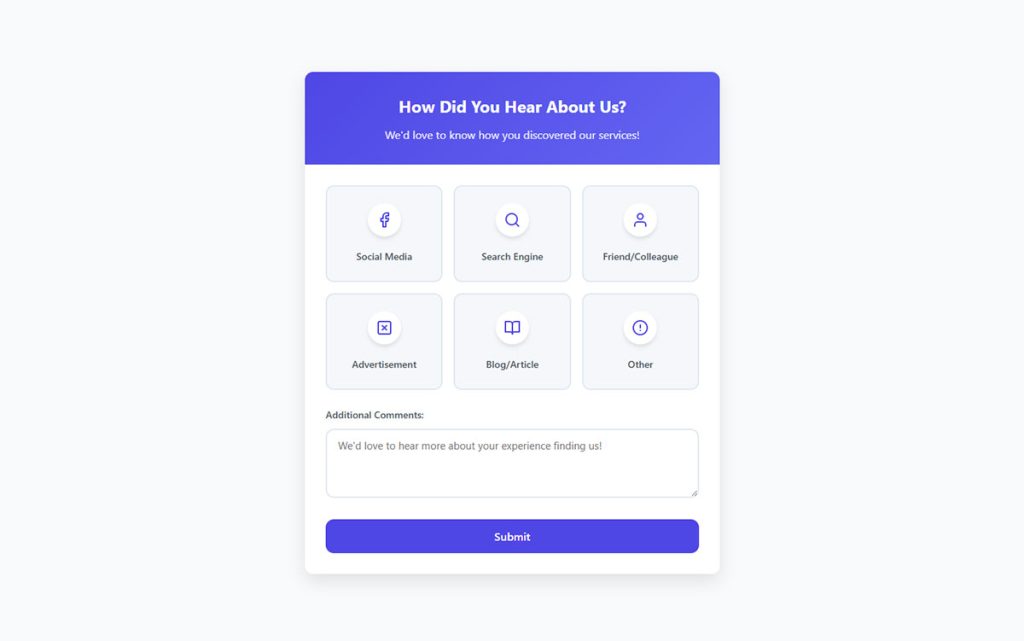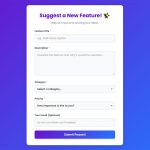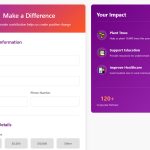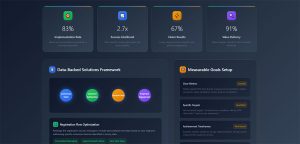You send a survey. Half your audience ignores it. The other half quits halfway through. Sound familiar? Survey fatigue is killing your response rates and destroying data quality. When participants…
Table of Contents
Ever wonder which marketing channels are actually driving customers to your business? The answer lies in implementing effective customer acquisition tracking tools on your website.
A well-designed “How did you hear about us” question on your contact forms provides crucial marketing attribution data that transforms your marketing effectiveness measurement. Without this form field, you’re essentially flying blind with your marketing ROI measurement.
In this comprehensive guide, we’ll explore practical examples of how did you hear about us template options that you can immediately implement in your:
- Customer feedback systems
- Registration form templates
- Lead generation forms
- Customer onboarding surveys
By the end, you’ll understand how to create source attribution questionnaires that boost your business intelligence while maintaining excellent user experience.
Examples Of How Did You Hear About Us Template
Multiple choice
See the Pen
Interactive “How Did You Hear About Us?” multiple-choice survey by Bogdan Sandu (@bogdansandu)
on CodePen.
Open-ended
See the Pen
Modern “How Did You Hear About Us” Survey by Bogdan Sandu (@bogdansandu)
on CodePen.
Checkbox (multi-select)
See the Pen
Modern Multi-Select Survey (How Did You Hear About Us?) by Bogdan Sandu (@bogdansandu)
on CodePen.
Dropdown list
See the Pen
Dropdown List Survey Form by Bogdan Sandu (@bogdansandu)
on CodePen.
Conditional/branched
See the Pen
Modern Survey with Conditional Branching by Bogdan Sandu (@bogdansandu)
on CodePen.
Channel-specific
See the Pen
Channel-Specific Survey by Bogdan Sandu (@bogdansandu)
on CodePen.
Embedded widget
See the Pen
Feedback widget survey by Bogdan Sandu (@bogdansandu)
on CodePen.
Gamified/interactive
See the Pen
Multiple Choice “How Did You Hear About Us” Survey by Bogdan Sandu (@bogdansandu)
on CodePen.
Email follow-up
See the Pen
Email follow-up survey by Bogdan Sandu (@bogdansandu)
on CodePen.
FAQ on How Did You Hear About Us Templates
What’s the best format for a “How did you hear about us” question?
The best format depends on your goals. Dropdown menu options work well for specific marketing channel attribution, while open-ended questions capture unexpected customer touchpoints. For data collection templates, multiple-choice with an “Other” option balances structure with discovery.
Should I include social media platforms individually or group them?
List major platforms (Facebook, Instagram, etc.) separately in your form field examples to track marketing effectiveness measurement accurately. This granular approach improves your marketing ROI measurement and helps identify which social media channels drive the most valuable leads.
How many options should I include in my template?
Include 5-8 main marketing channel options in your customer acquisition tracking form. Too many choices overwhelm users and reduce form completion rates. Focus on your active marketing channels and add an “Other” option to capture unexpected customer source tracking data.
Where should I place this question in my form?
Position your source attribution questionnaire near the end of your contact forms or lead generation forms. This improves user experience as people prefer answering personal questions first. By the time they reach your marketing attribution form question, they’re more invested in completing it.
How can I analyze the responses effectively?
Connect your customer source tracking data to your CRM systems like Salesforce or HubSpot. This integration enables marketing funnel analysis and helps calculate customer acquisition cost by channel, informing future marketing channel effectiveness decisions.
Should I make this field mandatory?
Making your lead source identification field optional typically improves conversion tracking without hurting completion rates. However, for B2B marketing contexts where marketing attribution data is crucial, consider making it required on customer intake questions.
Can I customize templates for different business types?
Yes! Tailor your customer acquisition survey based on industry and audience. An e-commerce store using Shopify needs different customer discovery questions than a B2B service using WordPress. Consider your unique customer journey mapping needs.
How often should I update my template options?
Review your marketing source feedback options quarterly. As you add or remove marketing channels, update your form question examples accordingly. This ensures your marketing channel survey accurately reflects current customer touchpoint analysis opportunities.
What’s the difference between direct and indirect attribution?
Direct attribution in your source tracking dropdown identifies immediate referrers (Google search, Facebook ad). Indirect attribution captures the full customer journey with multiple touchpoints. Sophisticated marketing attribution models track both for complete marketing effectiveness measurement.
Should I use this template on all customer-facing forms?
Implement your customer origin tracking question strategically. Include it on registration form templates and lead generation forms, but perhaps not on support requests. Use tools like Google Analytics alongside form templates for comprehensive marketing source tracking.
Conclusion
Implementing effective examples of how did you hear about us template options transforms your marketing ROI measurement from guesswork to precision. Your customer acquisition metrics will finally make sense, and your marketing budget decisions become data-driven.
The right customer discovery questions create a foundation for:
- Better lead source identification
- Improved marketing channel effectiveness
- More accurate customer acquisition cost calculations
- Clearer understanding of your customer journey mapping
Remember that form design examples should balance data collection with user experience. A well-crafted source tracking dropdown integrated with tools like Mailchimp or Typeform provides the insights needed for smarter marketing.
Don’t let valuable customer source tracking data slip away. Start implementing these form field options today. Your marketing attribution models will become more sophisticated, your business intelligence will improve, and your market research will finally show which channels truly matter for your growth.







